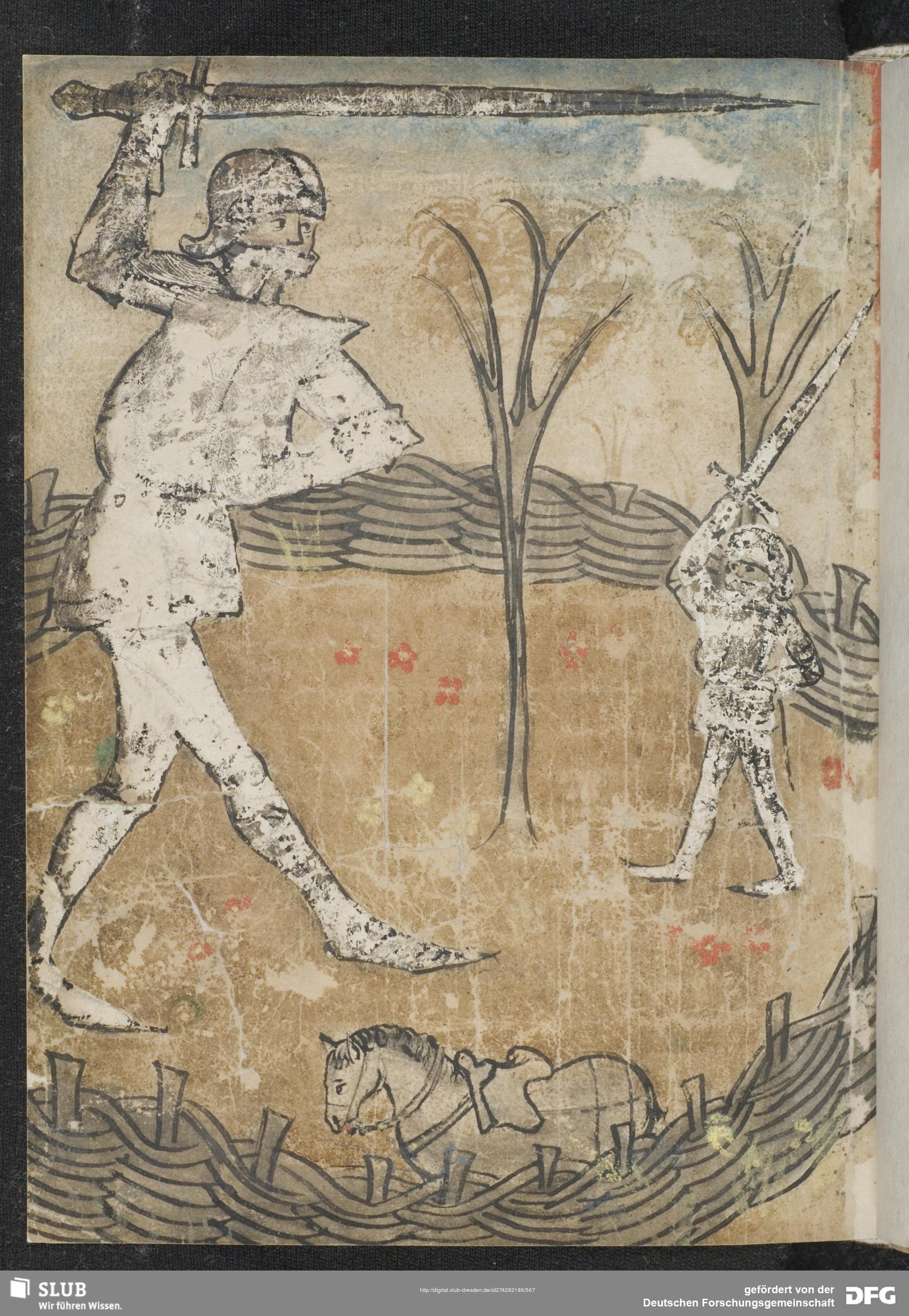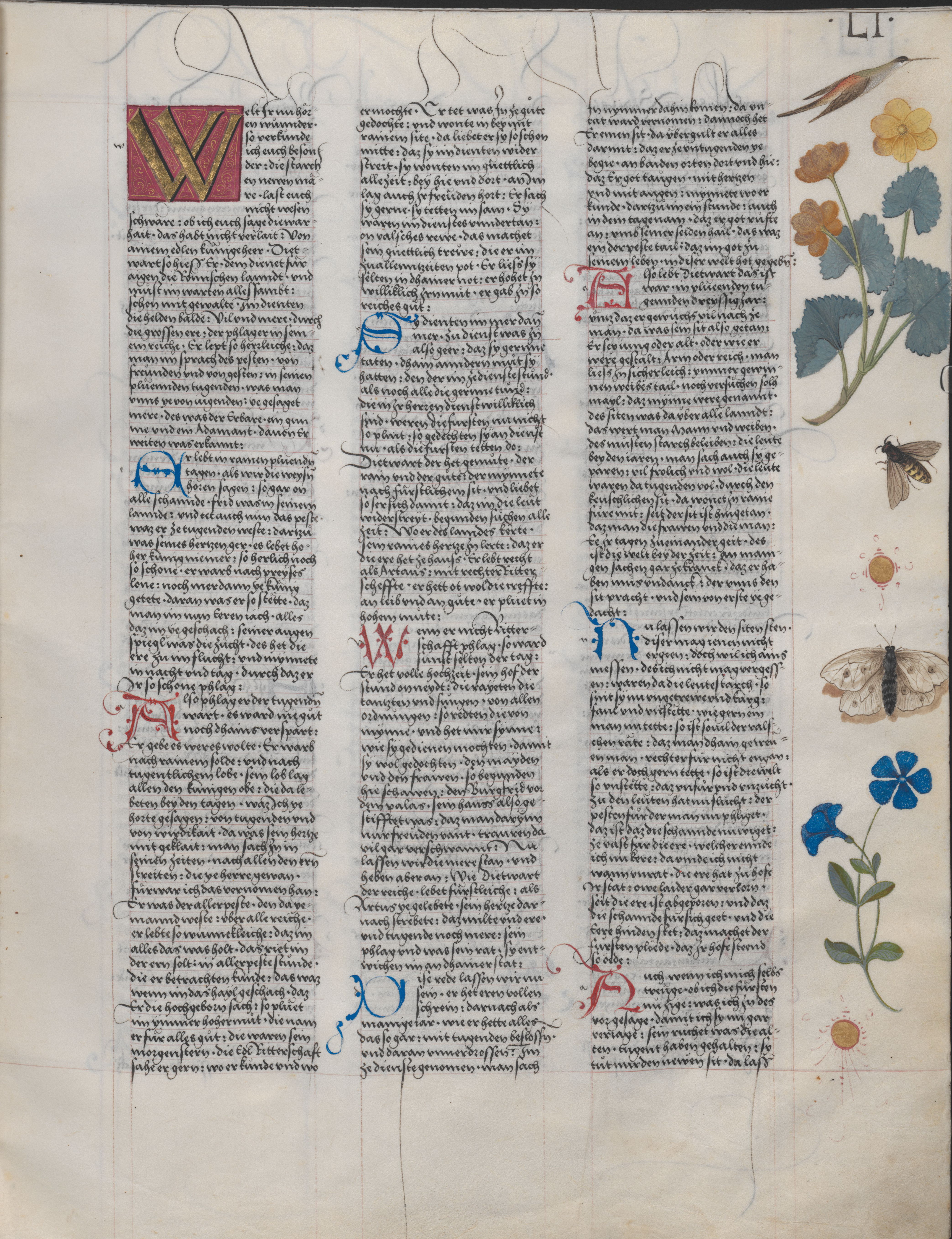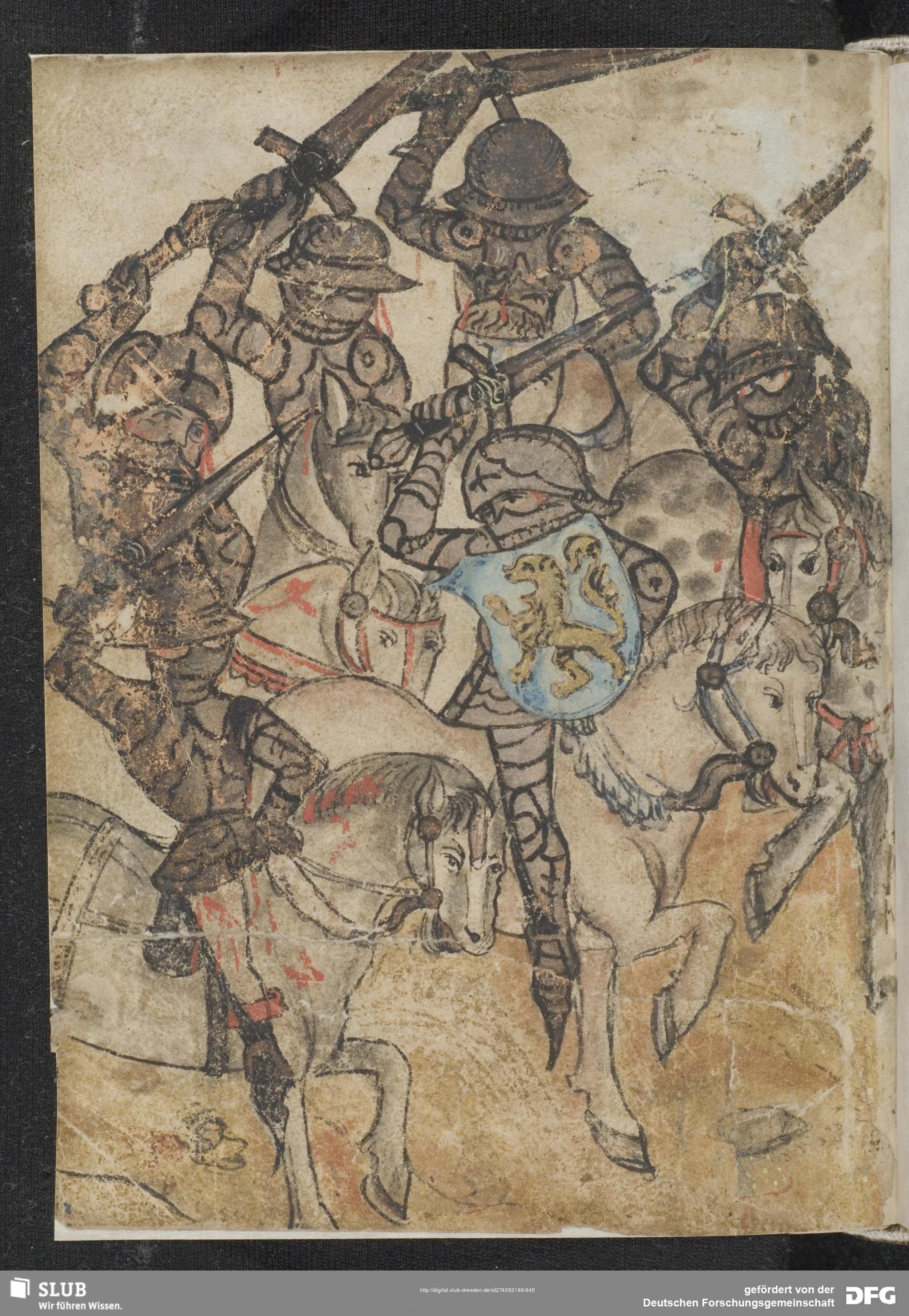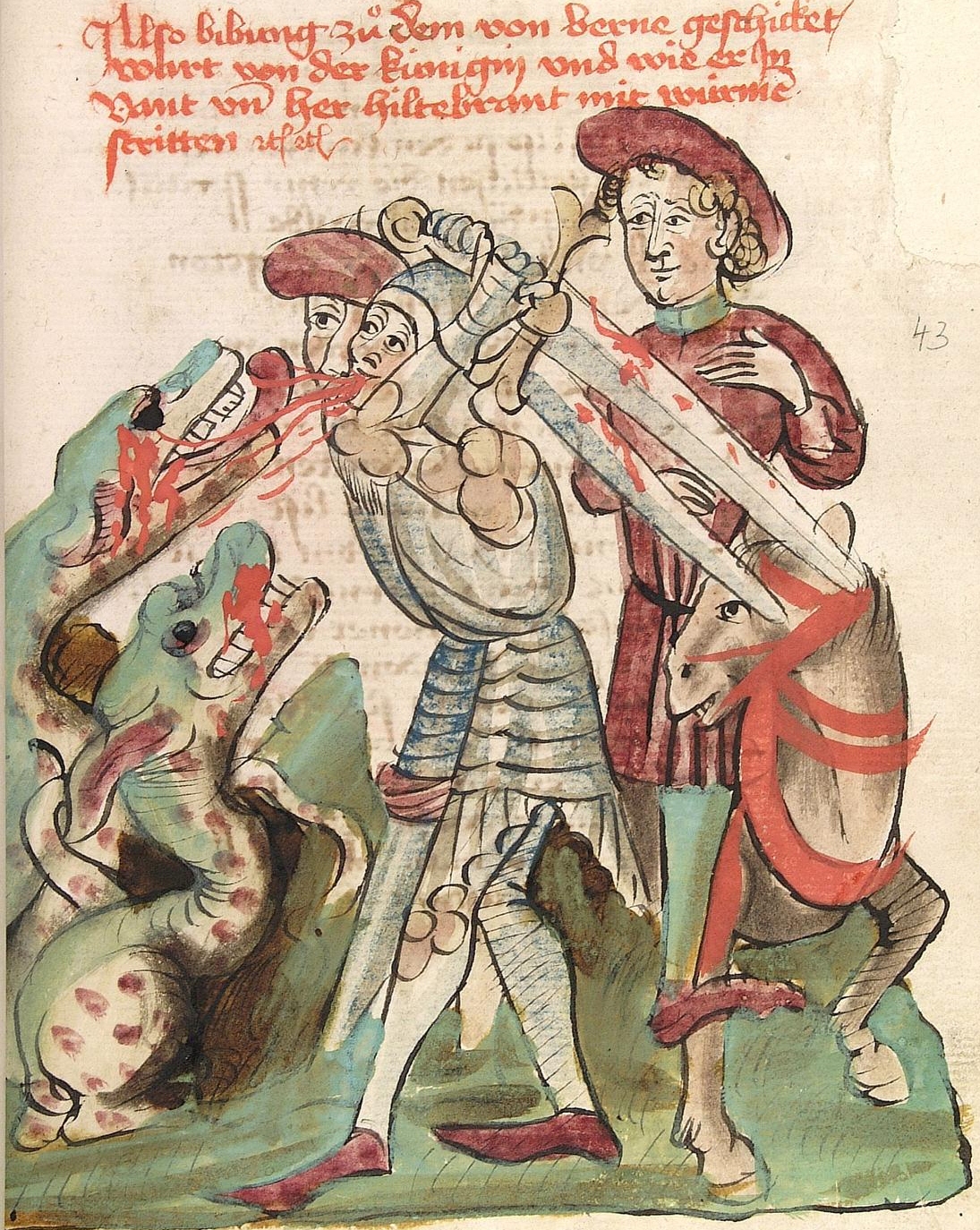|
Witege
Witege, Witige or Wittich ( ang, Wudga, Widia; Gotho- lat, Vidigoia) or Vidrik "Vidga" Verlandsson ( + ''Viðga'' or ''Videke'' + ''Verlandsson'', ''Vallandsson'', or ''Villandsson'') is a character in several Germanic heroic legends, poems about Dietrich von Bern, and later Scandinavian ballads.The article Vidrik Verlandsson' in ''Nordisk familjebok'' (1921). In German legends, he was one of the warriors of Dietrich von Bern, but betrayed him and took instead the side of his wicked Uncle Ermenrich. In one of the Scandinavian ballads (TSB E 119), he won particular fame in his duel with Langben Rese/Risker (the giant Etgeir in the '' Þiðrekssaga''). During the Middle Ages, he became the son of Wayland the Smith and Böðvildr, and this entitled him to carry a hammer and tongs in his coat of arms. Later the origin of his name "Wayland's son" was forgotten, but the fame of the character prevailed. During the 16th and the 17th centuries, this led to the idea that his name " ... [...More Info...] [...Related Items...] OR: [Wikipedia] [Google] [Baidu] |
ALPHART
''Alpharts Tod'' (The Death of Alphart) is an anonymous late medieval Middle High German poem in the poetic cycle of the hero Dietrich von Bern, the counterpart of the historical Ostrogothic king Theodoric the Great in Germanic heroic legend. It is part of the so-called "historical" Dietrich material. It may have written as early as between 1245 and 1300, but it is only transmitted in a single manuscript from around 1470 or 1480. The place of composition is unknown. ''Alpharts Tod'' concerns the young hero Alphart, one of Dietrich's heroes and the nephew of Hildebrand, at the start of a war between Dietrich and his uncle Ermanaric, Ermenrich. Alphart insists on riding out alone, and while he is brave and a powerful warrior, he eventually encounters Witege and Heime, two traitors who have switched sides to Ermenrich. They kill him in a dishonorable fashion; Ermenrich, meanwhile, fails to defeat Dietrich. Summary The beginning of the epic is missing. Emperor Emenrich tells Heime to ... [...More Info...] [...Related Items...] OR: [Wikipedia] [Google] [Baidu] |
Alpharts Tod
''Alpharts Tod'' (The Death of Alphart) is an anonymous late medieval Middle High German poem in the poetic cycle of the hero Dietrich von Bern, the counterpart of the historical Ostrogothic king Theodoric the Great in Germanic heroic legend. It is part of the so-called "historical" Dietrich material. It may have written as early as between 1245 and 1300, but it is only transmitted in a single manuscript from around 1470 or 1480. The place of composition is unknown. ''Alpharts Tod'' concerns the young hero Alphart, one of Dietrich's heroes and the nephew of Hildebrand, at the start of a war between Dietrich and his uncle Ermenrich. Alphart insists on riding out alone, and while he is brave and a powerful warrior, he eventually encounters Witege and Heime, two traitors who have switched sides to Ermenrich. They kill him in a dishonorable fashion; Ermenrich, meanwhile, fails to defeat Dietrich. Summary The beginning of the epic is missing. Emperor Emenrich tells Heime to bring Erm ... [...More Info...] [...Related Items...] OR: [Wikipedia] [Google] [Baidu] |
Rabenschlacht
''Die Rabenschlacht'' (The Battle of Ravenna) is an anonymous 13th-century Middle High German poem about the hero Dietrich von Bern, the counterpart of the historical Ostrogothic king Theodoric the Great in Germanic heroic legend. It is part of the so-called "historical" Dietrich material and is closely related to, and always transmitted together with, a second Dietrich poem, ''Dietrichs Flucht''. At one time, both poems were thought to have the same author, possibly a certain Heinrich der Vogler, but stylistic differences have led more recent scholarship to abandon this idea. ''Die Rabenschlacht'' concerns a failed attempt by the exiled Dietrich to reclaim his kingdom in Northern Italy from his treacherous uncle Ermenrich, with the help of an army provided by Etzel, king of the Huns. In the course of this attempt, Dietrich's younger brother and Etzel's young sons by his wife Helche are killed by Dietrich's former vassal Witege outside of Ravenna. Witege then flees into the sea ... [...More Info...] [...Related Items...] OR: [Wikipedia] [Google] [Baidu] |
Laurin (poem)
''Laurin'' or ''Der kleine Rosengarten'' (''The Small Rose Garden'') is an anonymous Middle High German poem about the legendary hero Dietrich von Bern, the counterpart of the historical Ostrogothic king Theodoric the Great in Germanic heroic legend. It is one of the so-called fantastical (''aventiurehaft'') Dietrich poems, so called because it more closely resembles a courtly romance than a heroic epic. It likely originates from the region of South Tyrol, possibly as early as 1230, though all manuscripts are later. The poem has five extant versions. In each, it concerns Dietrich's fight against the dwarf King Laurin, which takes place when Dietrich and Witege destroy Laurin's magical rose garden. The heroes are subsequently invited into Laurin's kingdom inside a mountain when it is discovered that Laurin has kidnapped and married the sister of Dietleib, one of Dietrich's heroes. Laurin betrays the heroes and imprisons them, but they are able to defeat him and save Dietleib's sis ... [...More Info...] [...Related Items...] OR: [Wikipedia] [Google] [Baidu] |
Rosengarten Zu Worms
Dietrich and Siegfried from a 15th-century manuscript of the ''Rosengarten zu Worms'' ''Der Rosengarten zu Worms'' (the rose garden at Worms), sometimes called ''Der große Rosengarten'' (the big rose garden) to differentiate it from ''Der kleine Rosengarten'' ( ''Laurin''), and often simply called the ''Rosengarten'', is an anonymous thirteenth-century Middle High German heroic poem in the cycle of Dietrich von Bern. The ''Rosengarten'' may have been written as early as before 1250, but is securely attested by around 1300. It is unclear where it was written. While it combines characters from the traditions of the ''Nibelungenlied'', Walter of Aquitaine, and the Dietrich cycle, the ''Rosengarten'' is usually considered one of the so-called fantastical (''aventiurehaft'') poems about Dietrich: these poems more closely resembles a courtly romance than traditional heroic epic. Occasionally, because it features Dietrich fighting against human opponents rather than giants or dwarfs, i ... [...More Info...] [...Related Items...] OR: [Wikipedia] [Google] [Baidu] |
Dietrichs Flucht
''Dietrichs Flucht'' (Dietrich's Flight) or ''Das Buch von Bern'' (The Book of Verona) is an anonymous 13th-century Middle High German poem about the legendary hero Dietrich von Bern, the legendary counterpart of the historical Ostrogothic king Theodoric the Great in Germanic heroic legend. It is part of the so-called "historical" Dietrich material and is closely related to, and always transmitted together with, a second Dietrich poem, the ''Rabenschlacht''. A Heinrich der Vogler is named as author in an excursus of the poem. Earlier scholarship considered him to be the author of ''Dietrichs Flucht'' and possibly also of the ''Rabenschlacht'', however more recent scholarship believes he is only author of this excursus. ''Dietrichs Flucht'' describes the rule of Dietrich's ancestors in his kingdom in northern Italy; his betrayal and exile by his wicked uncle Ermenrich, and his flight to the Huns, where he is warmly received by Etzel and his wife Helche. With Etzel's help, Dietri ... [...More Info...] [...Related Items...] OR: [Wikipedia] [Google] [Baidu] |
Germanic Heroic Legend
Germanic heroic legend (german: germanische Heldensage) is the heroic literary tradition of the Germanic-speaking peoples, most of which originates or is set in the Migration Period (4th-6th centuries AD). Stories from this time period, to which others were added later, were transmitted orally, traveled widely among the Germanic speaking peoples, and were known in many variants. These legends typically reworked historical events or personages in the manner of oral poetry, forming a heroic age. Heroes in these legends often display a heroic ethos emphasizing honor, glory, and loyalty above other concerns. Like Germanic mythology, heroic legend is a genre of Germanic folklore. Heroic legends are attested in Anglo-Saxon England, medieval Scandinavia, and medieval Germany. Many take the form of Germanic heroic poetry (german: germanische Heldendichtung): shorter pieces are known as heroic lays, whereas longer pieces are called Germanic heroic epic (). The early Middle Ages preser ... [...More Info...] [...Related Items...] OR: [Wikipedia] [Google] [Baidu] |
Virginal (poem)
''Virginal'', also known as ''Dietrichs erste Ausfahrt'' (Dietrich's first quest), or ''Dietrich und seine Gesellen'' (Dietrich and his companions) is an anonymous Middle High German poem about the legendary hero Dietrich von Bern, the counterpart of the historical Ostrogothic king Theodoric the Great in Germanic heroic legend. It is one of the so-called fantastical (''aventiurehaft'') Dietrich poems, so called because it more closely resembles a courtly romance than a heroic epic. The poem was composed by 1300 at the latest, and may have been composed as early as the second quarter of the thirteenth century. There are three principle versions of the ''Virginal''. The poem concerns the still young and inexperienced Dietrich's quest to save the dwarf queen Virginal in Tyrol from a force of attacking heathens. After defeating the heathens, Dietrich encounters a series of further adventures while trying to reach Virginal's court, including, depending on version, his capture by giants ... [...More Info...] [...Related Items...] OR: [Wikipedia] [Google] [Baidu] |
Háma
Heime (German), Háma ( ang, Hāma), or Heimir (Old Norse) was a Germanic figure in Germanic heroic legend who often appears together with his friend Witige.The article Heimer' in '' Nordisk familjebok'' (1909). He appears in the Anglo-Saxon poems '' Beowulf'' and ''Widsith'', in the Scandinavian '' Þiðrekssaga'' and in German epics such as ''Alpharts Tod''.The entry ''Heime/Heimir'' in ''The Nibelungen Tradition: An Encyclopedia'' (2002) by Francis G. Gentry. p. 84 Origins Since Wudga is based on a Gothic hero named Vidigoia, it is possible that Hama has a similar origin, and the Anglo-Saxon poem ''Widsith'' talks of Hama and Wudga as Gothic warriors fighting against the Huns in the Vistula forests, where the Goths had an early settlement. Later, during the evolution of the legends, the two heroes were connected with both the Gothic kings Ermanaric and Theodoric the Great, and they were increasingly presented as traitors; it is as traitors that they appear in the '' Þiðrek ... [...More Info...] [...Related Items...] OR: [Wikipedia] [Google] [Baidu] |
Dietrich Von Bern
Dietrich von Bern is the name of a character in Germanic heroic legend who originated as a legendary version of the Ostrogothic king Theodoric the Great. The name "Dietrich", meaning "Ruler of the People", is a form of the Germanic name "Theodoric". In the legends, Dietrich is a king ruling from Verona (Bern) who was forced into exile with the Huns under Etzel by his evil uncle Ermenrich. The differences between the known life of Theodoric and the picture of Dietrich in the surviving legends are usually attributed to a long-standing oral tradition that continued into the sixteenth century. Most notably, Theodoric was an invader rather than the rightful king of Italy and was born shortly after the death of Attila and a hundred years after the death of the historical Gothic king Ermanaric. Differences between Dietrich and Theodoric were already noted in the Early Middle Ages and led to a long-standing criticism of the oral tradition as false. Legends about Theodoric may have exi ... [...More Info...] [...Related Items...] OR: [Wikipedia] [Google] [Baidu] |
The Types Of The Scandinavian Medieval Ballad
''The Types of the Scandinavian Medieval Ballad: A Descriptive Catalogue'' (TSB) is the designation for a cataloguing system for Scandinavian ballads. It is also the title of the underlying reference book: ''The Types of the Scandinavian Medieval Ballad: A Descriptive Catalogue'', edited by Bengt R. Jonsson, Svale Solheim and Eva Danielson, in collaboration with Mortan Nolsøe and W. Edson Richmond, published in 1978 in two places: as volume 5 of the series Skrifter utgivna av svenskt visarkiv (Stockholm: Svenskt visarkiv), and as volume 59 of series B of Oslo's Instituttet for sammenkignende kulturforskning (The Institute for Comparative Research in Human Culture) (Oslo, Bergen, and Tromsø: Universitetsforlaget; ). It attempts to classify all specimens of traditional ballads known in one or more of the Scandinavian languages (Danish, Norwegian, Swedish, Icelandic, Faeroese, and the extinct Norn). Structure and scope Cognate ballads are assigned the same "TSB No." such as "A ... [...More Info...] [...Related Items...] OR: [Wikipedia] [Google] [Baidu] |








